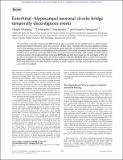Entorhinal–hippocampal neuronal circuits bridge temporally discontiguous events
Author(s)
Kitamura, Takashi; MacDonald, Christopher J; Tonegawa, Susumu
DownloadKitamura-2015-Entorhinal-hippocamp.pdf (510.6Kb)
PUBLISHER_CC
Publisher with Creative Commons License
Creative Commons Attribution
Terms of use
Metadata
Show full item recordAbstract
The entorhinal cortex (EC)–hippocampal (HPC) network plays an essential role for episodic memory, which preserves spatial and temporal information about the occurrence of past events. Although there has been significant progress toward understanding the neural circuits underlying the spatial dimension of episodic memory, the relevant circuits subserving the temporal dimension are just beginning to be understood. In this review, we examine the evidence concerning the role of the EC in associating events separated by time—or temporal associative learning—with emphasis on the function of persistent activity in the medial entorhinal cortex layer III (MECIII) and their direct inputs into the CA1 region of HPC. We also discuss the unique role of Island cells in the medial entorhinal cortex layer II (MECII), which is a newly discovered direct feedforward inhibitory circuit to CA1. Finally, we relate the function of these entorhinal cortical circuits to recent findings concerning hippocampal time cells, which may collectively activate in sequence to bridge temporal gaps between discontiguous events in an episode.
Date issued
2015-09Department
Massachusetts Institute of Technology. Department of Biology; Picower Institute for Learning and Memory; RIKEN-MIT Center for Neural Circuit GeneticsJournal
Learning & Memory
Publisher
Cold Spring Harbor Laboratory Press
Citation
Kitamura, Takashi, Christopher J. Macdonald, and Susumu Tonegawa. “Entorhinal–hippocampal Neuronal Circuits Bridge Temporally Discontiguous Events.” Learning & Memory 22, no. 9 (August 18, 2015): 438–443.
Version: Final published version
ISSN
1549-5485
1072-0502